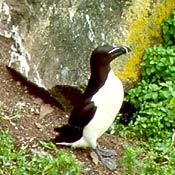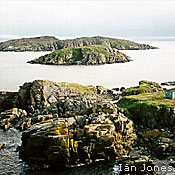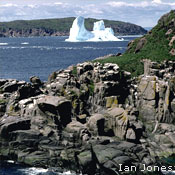Not a single Northern Gannet can be found on the seven islands that belong to the Gannet Islands Ecological Reserve. The name comes from a 19th-century British survey ship. That said, there is no shortage of seabirds on the remote island group 40 km northeast of Cartwright. The reserve is the largest and most diverse seabird breeding colony in Labrador.

- How to get There
- Activities
- Maps
- Services
- Fees and Schedules
- Rules and Regulations
- Permits
- Other Resources
- Contact Information
The Gannet Islands Ecological Reserve protects the largest Razorbill colony in North America, with more than 15,000 breeding pairs. It also protects the third-largest Atlantic Puffin breeding colony in North America (after Witless Bay and Baccalieu Island Ecological Reserves), with more than 38,000 pairs of these ‘sea parrots’.
The Gannet Islands also host 36,000 breeding pairs of Common Murres and 1,900 breeding pairs of Thick-billed Murres, and scores of Black-legged Kittiwakes, Great Black-backed Gulls, and Northern Fulmars. During summer, the islands are also a staging area for Harlequin Ducks preparing for their southern migration.
The islands are in Labrador’s Coastal Barrens ecoregion (681 KB), and so their interior has tundra vegetation, mainly dwarf sedges, low-lying heaths, and shrubby plants. But it is the slopes of boulder scree, rock cliffs, and turf that provide habitat for the Razorbills and Puffins.

The low-lying, rocky Gannet Islands were used as a landmark by sailors for centuries. Today, due to the significance and sensitivity of the site, visits to the reserve are restricted to scientific researchers only.
The Gannet Islands were established as a wildlife reserve in 1964. In 1983 they were designated the Gannet Islands Ecological Reserve, after the Wilderness and Ecological Reserves Act was passed. The reserve takes in 22 km2; 20 km2 of which is a marine component.
How to get there
The Gannet Islands are located off the coast of Labrador, 40 km northeast of Cartwright. There is no public access to the islands; visits are for scientific research only.
Activities
No activities are permitted on the islands other than scientific research. For more information and research guidelines, see Science and Research.
Commercial and recreational fishing can occur in the waters of the reserve. All provincial and federal regulations apply when fishing in the reserve. Boaters must be careful in the marine portion of the reserve so as not to disturb the birds.
Services
There are no services within the reserve.
There is one research cabin, operated by the Canadian Wildlife Service, on Gannet Cluster 2.
Fees and Schedules
Scientific research permit applications must be submitted to the Natural Areas Program by March 31 for review by the Seabird Ecological Reserves Advisory Committee. Email naturalareas@gov.nl.ca for more information. There are no fees involved in obtaining scientific research permits.
Rules and Regulations
Biodiversity protection and habitat conservation are two of the key purposes of ecological reserves, so certain rules apply within all the reserves in the province.
The public can visit most ecological reserves for educational purposes or low-impact recreational activities-such as hiking or sightseeing. These activities are prohibited in the Gannet Islands, due to the significance and sensitivity of the site. Access is limited to individuals conducting approved scientific research under permit.
It is important that any boaters approaching the islands do so carefully, so as not to disturb the birds.
Read the official reserve regulations:
Regulations and a management plan are pending for the Gannet Islands Ecological Reserve.
Adobe® Acrobat® Reader software can be used for viewing PDF documents. Download Acrobat® Reader for free

